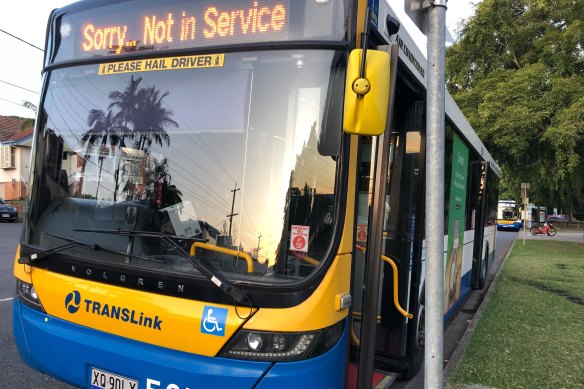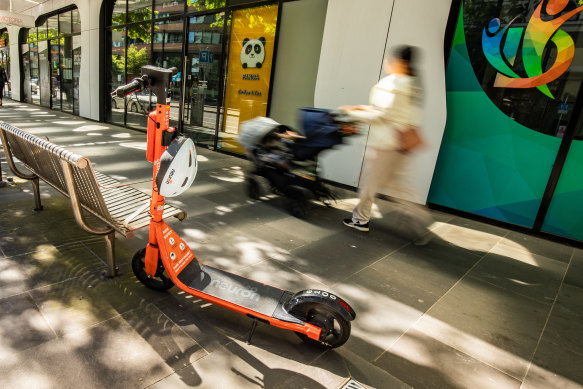This was published 2 years ago
Opinion
COVID lockdowns are over: Why didn’t Brisbane return to buses and trains?
Felicity Caldwell
JournalistThe way people travel around Brisbane has changed.
While life (mostly) returned to normal after pandemic lockdowns, the number of trips taken on buses, trains, ferries and trams in south-east Queensland is still only 84 per cent of what it was in January 2020.

Patronage on buses has not returned to pre-COVID levels.Credit: Felicity Caldwell
That equates to about 2.1 million fewer trips taken on public transport in January 2023 versus January 2020.
Authorities on Tuesday, February 28 celebrated the busiest day on public transport since COVID-19, with more than 620,000 trips taken.
But even though that was the day of Harry Styles’ concert - with tens of thousands of fans travelling to the Gold Coast - total public transport trips were still just 83 per cent of what they were on the same day in 2019.
So, what happened?
If we break down by mode of travel from July 2018 by month, it reveals buses and trains were hit hard - with trips dropping as low as 17 per cent of pre-COVID levels during the first tranche of restrictions - and they have not recovered to pre-pandemic levels.
Trams bounced back after all interstate border restrictions were lifted in January 2022, leading to the return of tourists to the Gold Coast, and trams are now on par with pre-pandemic levels.
Ferry trips plummeted at the start of COVID but suffered a sharper downturn in February 2022 due to floods and damage to CityCat terminals.
Ferry patronage was still at just 70 per cent of pre-pandemic levels in January 2023, and the final two CityCat terminals were reopened after repairs in late February.
The failure to lure everyone back to public transport contrasts with Queensland’s increasing population, with the state recording the largest net gain of people moving from another state - up 107,500 people - in the five years before the 2021 Census.
However, people did not swap public transport for private vehicles. Road traffic also experienced lockdown drops and remains slightly down on three years ago.
This shows despite more people living here, they are moving around differently.
One theory to explain the shift away from public transport is that employees demanded flexibility after getting a taste for remote working.
The latest official data, from the Census, shows 21 per cent of people worked at home in Brisbane in early August 2021, just as the city emerged from its fifth COVID lockdown, versus about 5 per cent in 2016.
TransLink data shows Mondays and Fridays are slightly slower to return to pre-COVID public transport levels compared with mid-week, while weekends are back to normal.
But WFH is not the whole story.
In late April 2020, the World Health Organisation urged people to walk or cycle where possible and avoid public transport during peak hours, resulting in a spike in active travel.
Brisbane bikeway counters show people enthusiastically took up riding in 2020, but numbers have eased, potentially due to bad weather at the start of 2022 or abandoned lockdown hobbies.
But it is the surging popularity of e-scooters in Brisbane, after the first hire schemes arrived in 2018, that may explain where many public transport passengers have gone.

Many people seem to have abandoned public transport for e-scooters.Credit: Scott McNaughton
Data from Ride Report - not including private e-scooters - shows the average number of e-scooter trips per day in Brisbane increased by 370 per cent from October-December 2019 to 2022.
Over the past three years, the average trip distance was two kilometres and just under 13 minutes.
Beam data showed Brisbane’s lockdowns did not noticeably affect monthly trips, while the city’s warm climate made scooting more attractive than cycling or walking, especially during steamy afternoons.
Transport Minister Mark Bailey said more Queenslanders opting for bike riding, walking, e-scooting and running was a pandemic trend that reinforced the need for more investment in active transport infrastructure.
“Which is why we’re delivering $278 million worth of active transport infrastructure over the next four years,” he said.
“The evidence also shows women are less likely to cycle when they have to interact with vehicles, which means we need to build more separated cycleways to encourage not only women, but everyone to cycle, walk and use active transport more.
“That’s why I’ve mandated that all new major infrastructure projects include active transport options.”